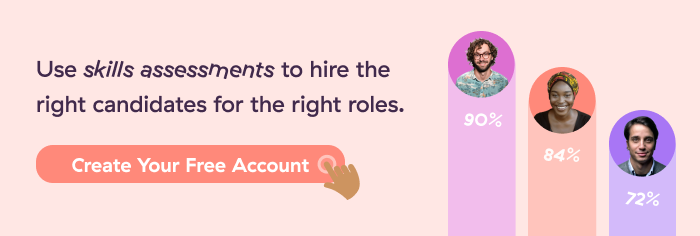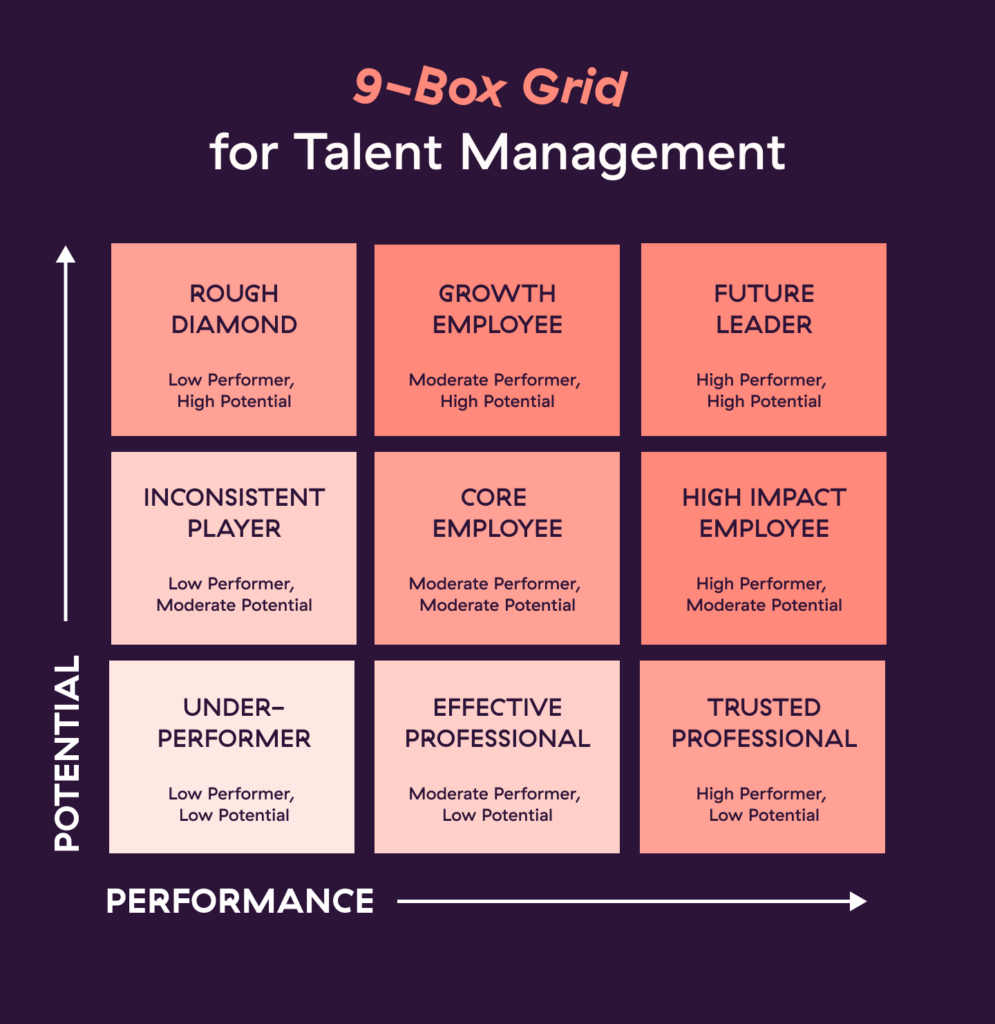Navigating the talent pool can be a challenging task for any organization — especially if you need to fill a role fast. However, sometimes the best candidates are already part of your team.
Internal recruitment is the concept of filling a job opening with an existing employee from your company, whether via promotions, transfers, or bringing temporary employees on full-time.
63% of employees feel a lack of career progression is a reason to resign, so by making opportunities available to them, you’ll win loyalty, boost employee retention, and have a more fulfilled workforce.
Sound like a good deal? Read through our strategic insights on how to effectively implement internal recruiting strategies and tips to make the most of this often-overlooked approach.
TL;DR — Key Takeaways
Internal recruitment is the process of filling a position from within the company, rather than hiring with an external hire, which offers benefits such as cost-efficiency, reduced time to hire, a better culture fit, and reduced turnover.
It’s not all sunshine and rainbows, though. This recruitment strategy can also create a skills gap in the workforce and lead to a lack of fresh perspectives. Over time, this can lead to stagnation and reduced diversity.
You’ll want to take some strategic measures to successfully implement an internal recruitment process. Set up a clear internal hiring policy, use the 9-box grid for succession planning, and ensure you’re still screening for skills, even if the hire is coming from inside the house.
It’s also important to be as fair and transparent as possible. You don’t want to risk leaving a bad taste in your internal candidates’ mouths. At the end of the day, they’re still part of your existing workforce.
Having the right tools, like skills tests integrated with your ATS, can help manage everything seamlessly by cutting screening time, structuring interviews, and providing feedback effortlessly.

Advantages of internal recruitment
Before diving in too deep and reworking your entire recruiting process, it’s important to weigh the advantages of internal recruitment against the possible disadvantages. So, let’s start by exploring some of the perks of internal recruitment.
Cost-efficiency
Internal recruitment often saves you money. It tends to be more cost-effective than external recruitment for a few reasons:
No need for expensive job openings, ads, or external recruitment agencies
Reduces the cost of training and onboarding since employees are already familiar with the company’s culture and operations
Salaries of external hires are usually 18-20% higher than internal hires
Overall, external recruitment costs $1,000-$5,000 more than internal recruitment per position, on average.
Reduce time to hire
The internal recruitment process can be quicker because you already have a bunch of data on your current employees’ skills and performance. This means you can skip certain steps in the recruitment process, such as initial screenings or background checks, since you already know your candidate.
Still, it’s important to keep the hiring process fair. Having the right hiring software can help a lot. Tools like Toggl Hire keep the process fair and efficient by organizing candidates according to their skills and key competencies rather than any other metric.

Ensures cultural fit
New hires take some time to settle into the culture of any new company they join. Plus, there’s always the risk that they don’t end up being a great fit for the wider team, no matter how charming they were in the interviews.
On the flip side, you can be sure an internal hire will fit well within a team because they already feel at home in your company. They fit like a glove into the wider culture and understand how everything works, which is key not only for job satisfaction but overall team performance and morale.
Easier onboarding
While you might have to provide some onboarding and assistance to an internal hire, you don’t have to onboard them from zero — they’ve already gone through that!
This means that, with internal recruiting, you’re getting someone already familiar with company policies and procedures. They can easily navigate your organization, and they know who to go to with questions or concerns.
Because they don’t require extensive training and are ready to hit the ground running sooner, this leads to quicker productivity and higher efficiency.
Decrease employee turnover
Internal recruiting is a great way to boost employee morale by showing you value your current employees’ work and career growth. This is especially important when you consider that lack of career progression is one of the main reasons people leave their jobs.
According to one LinkedIn report, employees stay 41% longer at companies that focus on hiring internally compared with those that don’t.
Reducing employee turnover has positive knock-on effects on other recruitment areas, too. For example:
Less turnover means more cost savings
Improved team morale
More internal team cohesion
More resources focused on fostering a great culture rather than constantly looking for external candidates

Disadvantages of internal recruitment
After reading the advantages of internal recruiting above, you might be ready to implement your own internal recruitment strategy — now. However, like any hiring strategy, there are also drawbacks to consider.
Here are a few of the biggest challenges that arise with an internal hiring process and when it might not make sense to look for internal candidates.
Skills gaps in the existing workforce
Making internal hires naturally leaves a gap that needs to be filled — their old responsibilities need to be covered by someone else. This could lead to a domino effect of internal reshuffling to get all bases covered, which would be a hit to productivity.
Alternatively, you could find yourself posting an external job description for the internal hire’s old position to bridge the skills gap, but this defeats the purpose of hiring internally to begin with.
One possible way to fix this issue is to split the responsibilities among colleagues. Be careful with this, though, as increasing responsibilities without also increasing pay can cause major dissatisfaction (and rightfully so), so only use this as a temporary solution or as part of a promotion that includes increased salary.
Limited applicant pool
Recruiting internally restricts the pool of applicants for new roles. This means you could be missing out on fantastic talent from public job vacancies.
Not only this, but cutting off external candidates from your company could lead to complacency among employees who don’t benefit from fresh, new ideas or hinder diversity within the company.
For example, imagine a company struggling to get their revenue up. A senior sales manager just made the internal jump to chief revenue officer and wants to double down on tactics that have worked in the past to get the company to their goals.
However, because they’ve been with the company for so long, they fail to laterally connect the dots the way someone with a fresh set of eyes might. After all, what gets you from 1 to 10 might not work to get you from 10 to 100.
Lack of fresh perspectives
Along the same lines, taking on an internal candidate can limit the influx of new ideas that external candidates might bring.
To quote David Ogilvy on the importance of innovation, “Change is our lifeblood, stagnation our death knell.” Don’t let your team miss the forest for the trees by abandoning fresh perspectives.
In that vein, it might be more beneficial to look for external hires when you need:
To target a new audience segment or enter a new market
Fresh leadership to take the company to new heights
Design work as part of a new product launch or rebranding
You’re developing innovative in-app features or product solutions

When to recruit internally
Internal recruitment can help your business flourish, but as you can see, it’s not without its limitations. The key is knowing when and how to use it. Here are some general guidelines to help set you up for success with internal recruitment:
🌟 Evaluate the various factors that affect whether internal or external recruiting is best for you: This includes factors such as the skills required and the availability of qualified candidates within the organization.
🌟 Figure out what the role really needs: Perhaps the role would benefit more from someone who already has an insider’s perspective, for example, in very niche or technical industries or a position that requires knowledge of extensive company history. Then, hire accordingly.
🌟 Systematically differentiate between your external and internal candidates: This could be by creating external and internal job boards, for example, so the source of your candidates appears differently in your ATS.
🌟 Choose the best person for the job: Don’t choose an internal hire simply because they’re already an existing employee. Offering internal candidates the position on merit and skills will help lower the risk of colleagues feeling resentful or unfairly overlooked.
🌟 Reward loyalty: Internal recruitment can be a good option when you want to reward loyalty, encourage retention, and boost morale by offering career progression opportunities to existing employees.
🌟 Create an internal job board: Current employees should be able to easily see which opportunities are available to them.
🌟 Consider internal recruitment during times of rapid growth or restructuring: It can be quicker and more cost-effective than external hiring during these types of changes.
Common approaches to internal recruitment
There is no catch-all approach to internal recruitment. Open positions can be filled in a number of ways that don’t include job boards or recruiting externally. Here are a few of the most common ways companies recruit internally.
Promotions: These make the most sense to reward excellent performance and dedication from current employees. Giving a new job title to reflect increased responsibility can be a great way to fill a vacant position without recruiting externally. Just make sure compensation is adjusted accordingly, too.
Transfers: If an employee expresses interest in learning new skills, transferring them to a different department could be a great option! This not only empowers employees to own their career paths but also shows you have an organizational culture of continuous self-improvement and exploration, which is very attractive to top talent.
Internal job postings: Always be transparent with employees about open positions and encourage them to apply for the ones that are in line with their career goals. It might save hiring managers’ time while also boosting employee engagement if your current workforce feels like they get “first dibs” on a new position.
Employee referrals: Referrals are a great way to capture passive candidates who are already pre-qualified. If someone who’s already on your team vouches for them, you can be sure they possess at least some of the required skills for the role. Employee referrals can shorten your selection process, plus getting two friends on the same team is amazing for boosting morale.

Strategies for effective internal recruitment
As with anything else in business, When recruiting internally, having a well-thought-out strategy streamlines your hiring process and ensures you make the most of your existing talent pool. Below are several key strategies that can effectively drive your internal recruitment efforts.
Implement a clear internal hiring policy
Having a well-defined recruiting process is vital for success. Outline the process and criteria for consideration so employees who consider applying to an open position internally have a feel of where they stand.
Creating a standardized process as part of any internal hiring policy can ensure fairness and transparency and prevent any potential favoritism or bias from creeping into the process.
Ensure your policy covers guidelines for job postings, evaluation procedures, interview processes, communication timelines, and applicant confidentiality.
Consider succession planning
Succession planning simply means preparing existing employees for future leadership roles. Keeping a long-term vision when it comes to individual and company-wide growth can help identify and develop employees for advancement into leadership positions, making internal recruitment more seamless
Use the right recruiting tools
Using the appropriate recruitment tools, such as an internal job board or talent management software, makes managing internal recruitment efforts easier (which is the case with external hiring, too).
These tools save time, keep you organized, and help make internal recruitment work better. They help identify suitable candidates more efficiently, especially in the pre-employment screening phase.
Toggl Hire is a great all-in-one solution for skills testing, screening, and candidate management.
Carefully screen internal candidates
Even though your internal candidates are already with the company, you still need to screen their skills against the new job opening they’re applying for. Measuring existing job performance isn’t enough, especially if the nature of the new role is slightly different.
Let’s say you have a tech-whizz developer who applies internally for a tech leader position. While they may be great when coding, you will need to screen them for soft skills like conflict resolution, decision-making, management style, and communication to ensure they’ll be good at leading their team.
You can automatically zero in on the top 3% of candidates using skills tests. Read more about how engineering studio Producement did it.
Conduct structured interviews
Structured interviews consist of a pre-defined set of questions that are prepared in advance and asked of every candidate.
The hiring manager or HR department can use the answers and qualitative data to score the candidates and assess whether they will be a good fit for the role and if they should move up in the interview process. This helps gather relevant information and make more informed and unbiased hiring decisions.
While it’s good to script some of the questions, leave room for the natural flow of conversation. Building rapport with your candidate is important, and rattling off questions without allowing for organic connection will make the interview feel more like an interrogation.
Give constructive feedback
Taking too long to get back to candidates is a big no-no. In fact, it’s the #1 most common complaint from job seekers. 75% never hear back after applying, and 60% never hear back after an interview.
A very easy way to stand out and give candidates a great experience is by providing thoughtful feedback to both successful and unsuccessful candidates. With intentional feedback, a rejection letter turns into a learning opportunity.
This is even more important when the candidates you’re rejecting are also your employees. By showing them where they need to improve, you foster their development for future opportunities and show you care about their professional growth and well-being.
Invest in other internal mobility initiatives
Cross-departmental projects, job rotations, or mentoring programs can enhance employees’ skills and help them advance internally without applying for separate jobs. Internal mobility initiatives like these are great low-risk ways to prepare them for future internal recruitment opportunities.
3 tips for successful internal recruitment
Effectively implementing a recruiting strategy boils down to the following three main points. These are applicable regardless of whether you decide you’re looking for internal or external hires.
1. Follow fair hiring practices
Fairness and transparency are key in internal and external hiring alike. This includes clear communication about job openings, equal opportunity for all employees to apply, and unbiased selection processes.
Unfair hiring practices can create resentment among your wider workforce or among unsuccessful candidates, who might speak badly about your employer brand or even accuse you of unlawful discrimination, leading to legal issues.
2. Identify potential early
Identifying high-potential employees early on will save time later. Having your finger on the pulse of employee development and performance will make succession planning and targeted development efforts easier to manage.
A few great places to start identifying this potential are regular performance reviews, 360-degree feedback, and/or talent management software like Deel or Leapsome.
3. Encourage employee growth
Building a company culture that encourages continuous growth is vital to a fulfilled, productive, and innovative workforce. You can introduce this more systematically through training opportunities, mentorship programs, or clear career progression paths.
Our best tip is to let employees lead. Let them set development goals and access one-on-one time with their managers so they can receive feedback on how they’re progressing and what those managers can do to help.
Another simple but effective move is creating an #appreciation Slack channel to share public praise and reward employees for effort and improvement.

Hire your ideal candidate with Toggl Hire
Internal recruitment can be more cost-effective and lead to faster integration of new hires into their roles. On the flip side, if not handled properly, internal recruitment can cause tension within a team and rob companies of fresh perspective.
Ultimately, it’s important to know which scenarios lend themselves better to internal recruiting and execute your strategy accordingly. Doing so will lead to a fairer hiring process, a faster time to hire, and reduced costs.
Hiring, internally or externally, is much easier with the right tools. To screen candidates faster, structure your interviews, or send candidate feedback effortlessly, learn more about skills-based hiring with Toggl Hire, or create your free account now.

Julia is a freelance writer and fierce remote work advocate. While traveling full-time, she writes about the intersection of technology and productivity, the future of work, and more. Outside work, you can find her hiking, dancing, or reading in a coffee shop.







